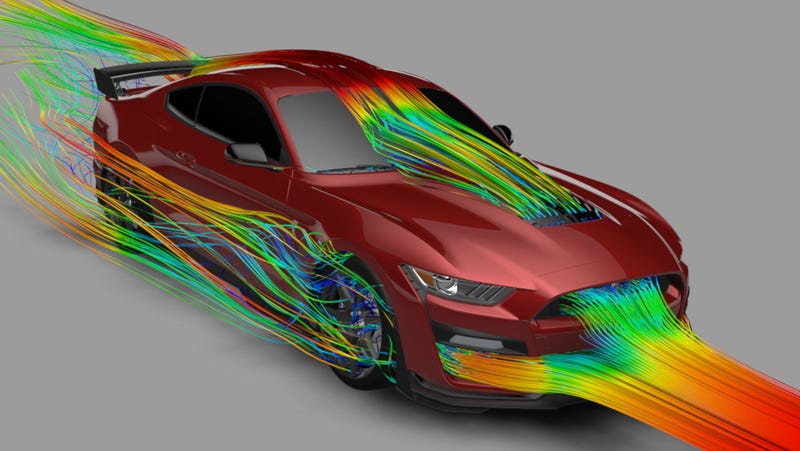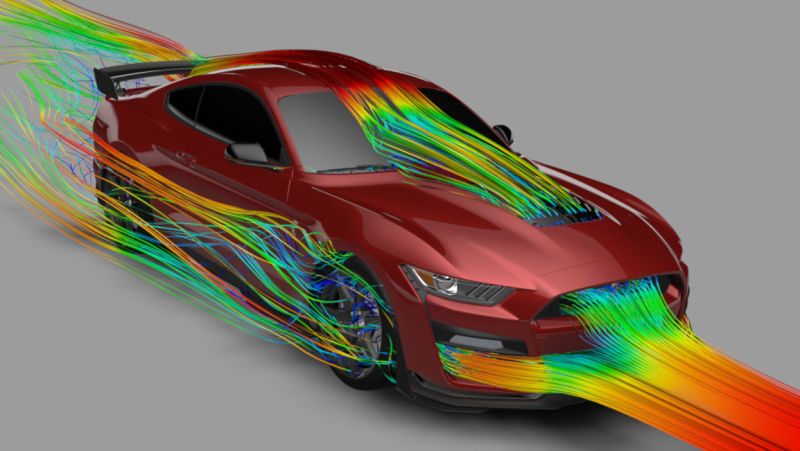
When the 2020 Ford Mustang Shelby GT500 debuted at the Detroit Auto Show in January, we wrote that it would “Slay Hellcats And Camaros With At Least 700 HP.” Two months later, we still don’t have an exact power figure, but we do have borderline-pornographic images of both cooling system hardware and aerodynamic simulations. Prepare your souls.
Car and Driver and other automobile websites are reporting that the Ford Mustang Shelby GT500 will be limited to a top speed of 180 MPH, and while I guess that’s interesting in that supercars tend to use top speed as a bragging right, I’m really more concerned with how this thing will handle on a track that isn’t straight.
And things that can really help in that environment are downforce and cooling—two areas linked in that they are a product of airflow (which, incidentally, is why at Fiat Chrysler, I used to work in a single department called “AeroThermal,” which dealt with both aerodynamics and powertrain cooling).

Anyway, Ford just dropped some details on the new 5.2-liter supercharged GT500, highlighting in a press release how its engineers used simulation tools and 3D printing to prove out aero designs.
Advertisement

The results of its simulation/3D printing process, Ford says, include a new rear spoiler/wing that the company calls “the swing,” which—along with an available Handling Package and Gurney flap—can yield 379 pounds of downforce at the back of the car at 180 MPH. Add a Carbon Fiber Track Package, though, and you get the Mustang GT4 race car’s rear wing, which offers up to 550 pounds of press at 180 MPH.

Advertisement
Other aero features that Ford highlights are a belly pan, optional side splitters, and front splitter that all reduce front end lift. Another feature that FoMoCo says helps accomplish that same task is the six square-foot hood vent (with a removable rain tray), but in addition to reducing lift, it improves powertrain cooling by reducing pressure aft of the cooling module.

While we’re on the topic of powertrain cooling, let’s be honest: While the pretty, colorful, modified computational fluid dynamics images above are neat, what you all want to see is cooling system hardware. And on that front, there’s good news:

Advertisement
Oh yes, just look at that. It’s an entire front end module as seen from the rear. Among the bits shown in the photo are a 600-watt electric fan that sucks air through the radiator, AC condenser, transmission cooler, and low temperature radiator (which Ford says provides cooling to the Supercharger—presumably this means it acts as an intercooler); a fan shroud with 16 “speed flaps” to provide additional airflow and reduced front end lift at high speeds; an auxiliary high temperature radiator that gets coolant though its own thermostat; and a vent in the left wheel liner to help air flow across the fins and tubes of the remote-mounted engine oil cooler.
Yes, I did just mention six heat exchangers, and that’s not even accounting for the differential cooler at the rear of the car. Clearly, this is an impressive cooling system, and to show it off, Ford’s got a sweet labeled cutaway here to help satiate all of your cooling system needs:

Advertisement
Have a look at those big brake ducts! Ford says they’re capable of extracting up to 100 kilowatts of heat from the 16.5-inch brake rotors, and I while that figure probably doesn’t mean much to you (it doesn’t to me), based on these images, those appear to be some big-ass ducts (here are the new Supra’s, for comparison).
And you know what else is big? The total size of the grille openings in the front end; Ford says they are “twice as large as the Mustang Shelby GT350.”

Advertisement
Gosh I can’t wait to see this thing up-close. I love cooling systems.













